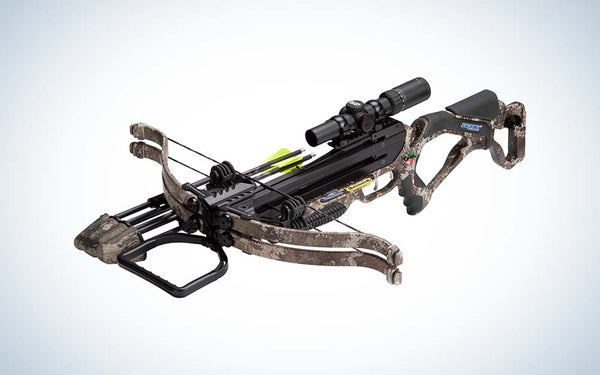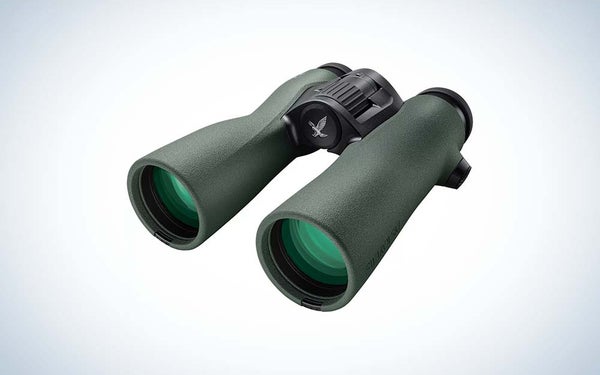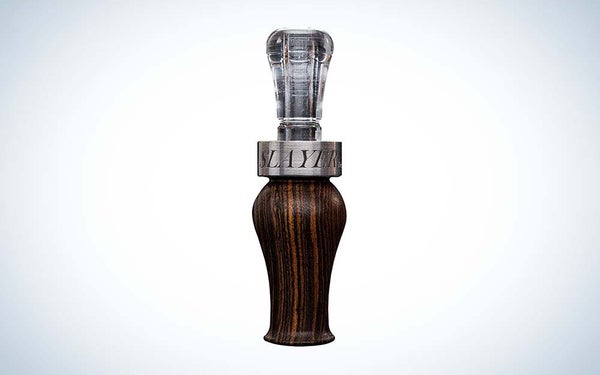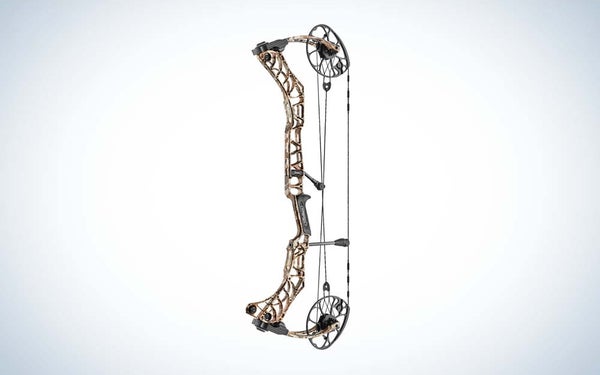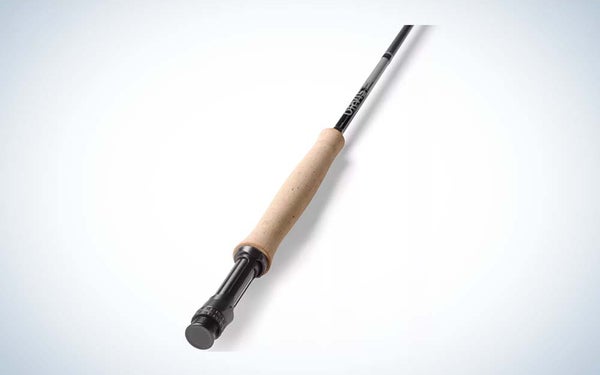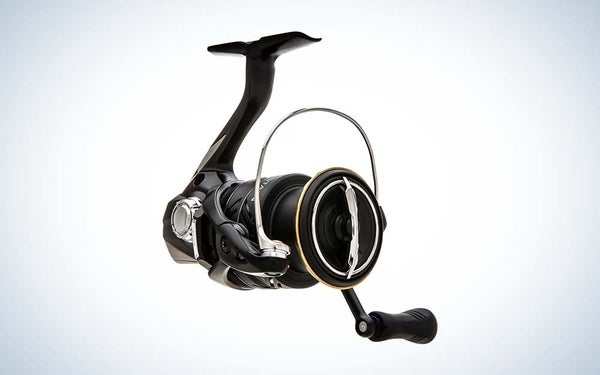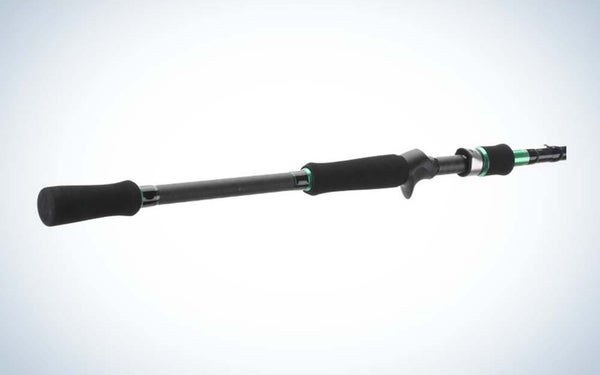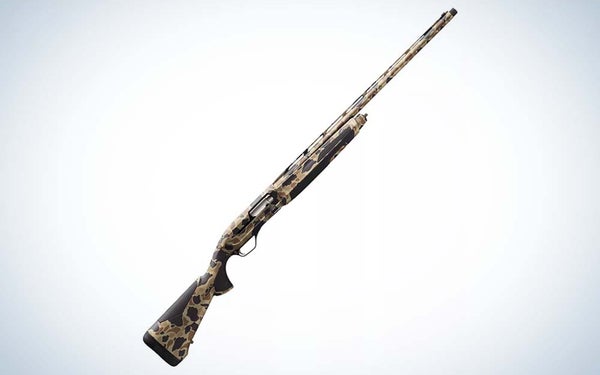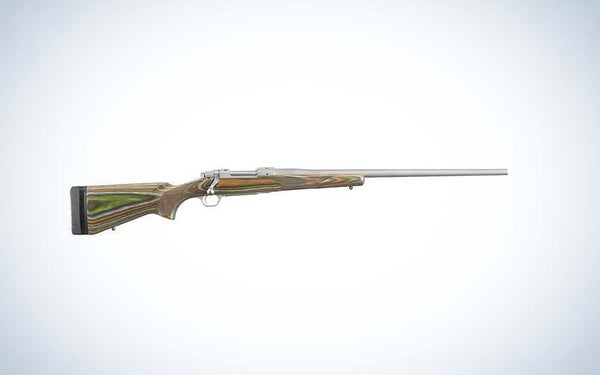Gear of the Year: F&S Picks the Absolute Best Hunting and Fishing Products of 2021
From a double-barrel crossbow to a dead accurate coyote gun, these are our favorites

We may earn revenue from the products available on this page and participate in affiliate programs. Learn more ›
For a lot of hunters and anglers, buying new gear takes trust. It’s easy to see why. Through the ups and downs of every season, we kind of build a relationship with our stuff. For something to make its way into the rotation it needs to hold up to abuse, and it needs to be something more than just a novelty.
The following guns, bows, rods, reels, and other gear won’t let you down. We’ve spent a year sifting through a mountain of outdoor equipment—subjected some of it to exhaustive tests—and figured out where your hard-earned cash is best spent. So make room in your packs, rod holders, and gun safes. Here’s the best gear of 2022.
The Best Hunting Gear of 2022
1) Excalibur TwinStrike Crossbow
Yes, I called this crossbow a “double-barreled abomination to bow seasons everywhere” when I reviewed it in-depth back in October. But you know what? I called my dog a block-headed @!$&*er just this morning, and I meant that, too. But I’ll still go outside right now to scratch his ears and call him a good boy, and he might just wilt in jubilation.
Truth is, crossbows destroyed the sanctity of real bowhunting long ago. The only practical way for a vertical bow snob like me to deal with it is just by embracing the coolest ones for what they are. And the two-shot Excalibur Twinstrike is decidedly cool. For a few years now, I’ve thought the simple recurve design didn’t always get a fair shake on paper, in a head-to-head test against a high-end compound crossbow. Recurves are louder, bulkier, more difficult to cock, and less powerful. But they’re also simple and reliable, and the type of crossbow I often recommend to hunting buddies who want something of quality, and don’t have to have the fastest thing made.
Somewhat ironically, the simple recurve design makes the two-shot TwinStrike possible. It’s really two crossbows in one—two barrels with two sets of limbs, two triggers, and two sears. Mine shot 1-inch groups at 30 yards—with both barrels—and averaged 365 feet per second. It was reliable in every way, too. It’s easy to cock with the removable Charger EXT Cocking Device, but it’s also possible to cock it with a standard rope—a feature that I especially like, because I’ve seen mechanical cocking devices fail. The TwinStrike costs $2,000, which is a pile of money but not as much as some of its flagship competition. For innovation that’s genuinely useful for hunters, it’s easily my favorite crossbow of 2022. Even if it is a #$%^ing abomination. —Will Brantley
Read Next: Excalibur’s New Double-Barreled TwinStrike Crossbow—Gimmick or Game-Changer?
4) Swarovski NL Pure Binoculars
Every once in a great while, a new binocular comes out that is nothing short of a revelation. You look through it and see things you’ve never seen before, in a way you’ve never seen them. Swarovski’s new NL Pure is far and away the best new binocular of the year and probably the best I have ever seen.
What you want from world-class glass is not just a perfect picture with stunning detail, but also, as the optics professor I used to test binoculars with used to stress, a feeling of immersion. With the NL Pure’s huge field of view and field-flattening lenses, you get the sense that you’ve stepped into the picture and that everything there is brilliant and vivid and free of the little aberrations common to lesser optics—field curvature, color shift, stray light—that otherwise distract you from the experience.
The other thing you want from a great hunting binocular is comfortable viewing, for hours on end. The NL Pure’s innovative hour-glass, open-bridge design not only saves weight but balances perfectly in the hand, making it easy to stabilize the binocular on long glassing sessions, and an available forehead rest adds to the comfort. The focus wheel is large and precise and takes you from a close-focus distance of 6.6 feet (for the 10x42s) to infinity in two silky revolutions. The diopter and eyecup adjustments are positive and exact. If you’re looking for a downside, you’ll find it only in the price. But, hey, the best doesn’t come cheap. Available in 8×32, 10×32, 8×42, 10×42, and 12×50 configurations. —Dave Hurteau
2) Slayer Duck Calls
Forty-seven years. That’s how long it’s been since I stood in Bob Wolfe’s swamp with my Pop’s Winchester Model 24 and with one shot (maybe two) became a waterfowler. Since then, I’ve used a lot of gear. You name it, and it’s been on my back or in my blind bag over the past five decades. And that includes calls. I’ve used big-name, no-name, single-reed, double-reed, and even one of Mr. Robertson’s triple-reed calls. But I treat duck calls like I treat my turkey vests. I try a new one every year then hang it up and go back to the same-old, tried-n-true, beat-up, call.
However, this year an acquaintance turned me on to a new company called Slayer Calls out of Eagle, Idaho. For starters, Slayer headquarters sits in one of the Pacific Northwest’s current hotbeds of ‘fowling opportunity. And if you haven’t heard of Idaho and ducks, well, you need to get out a little bit more.
Slayer makes pretty calls if that’s what you’re after—bocote wood, acrylic, color patterns with names like Yellow Jacket Mesh and Black Triple Curle. But pretty don’t kill ducks. Good duck sounds kill ducks, and thankfully Slayer delivers. This season, I’ve been using the Drake Slayer single reed, along with their recently-released Cutdown 00, and I like both. I’ve been using their Honker Slayer short reed goose call, too, and seeing things that I like, like twin O-rings. As for price point, Slayers run from $50 for the Mallard Reaper to $120 for a Drake Slayer or $160 for the short reed goose; all in the ballpark this day and age for a waterfowl call that should last a lifetime. —M.D. Johnson
3) Mathews V3 Bow
There were some great flagship bows introduced in 2022. Bowtech’s Solution, at 346 fps IBO, really is a remedy to their excellent but comparatively pokey 2020 Revolt. Elite’s Enkore is a fine follow-up to the smooth-shooting Kure. And Hoyt’s Ventum 30 is their best in years. But none did quite enough to dethrone Mathews and its groundbreaking CrossCentric Cam System, which has pretty much been the best in the business since it was introduced in 2016. As I’ve said before, the system delivers what every bowhunter wants: a fast bow that shoots like a slow one. As I get older, I can’t pull the weight I used to with some bows, but I can with Mathews’ latest offerings, and that’s no small thing.
With the V3, the company debuted a CenterGuard Cable Containment System designed to optimize cam timing and provide more vane clearance. The riser is lighter, too, and it’s longer in relation to axle-to-axle length, which, according to the company, allowed them to make a shorter overall bow without sacrificing accuracy and stability. You can see this easily on the 4.29-pound V3 27, which is the company’s shortest flagship bow ever at 27 inches. If you like a slightly longer bow, the company also offers a V3 31 version, which is 4 inches longer, less than a quarter-pound heavier, and has the same 349 fps IBO speed rating. Both, of course, have the CrossCentric Cam System, which as of last year, includes a mod that lets you change draw weight in 5-pound increments without touching the limbs. —D.H.
Read Next: The Best Hunting Compound Bows of 2022
The Best Fishing Gear of 2022
5) Orvis Helios 3 Blackout
You can’t say we didn’t come well-armed: In our flats skiff in the Bahamas, my buddy and I had five fly-fishing rods. They were all top-of-the-line sticks, and most had been proven in battle, except for a just-out-of-the-box, never-before-fished, 8-weight Orvis Helios 3 Blackout. Over two days of serious fishing, rarely was the Blackout stowed. Even with very good other choices literally at hand, time and again we reached for the new kid in town.
Instead of launching a traditional rod series with models across most rod weights, this year Orvis released the Helios 3 Blackout in three different models. There is a 3-weight 11-footer; a 9 1/2-foot 5-weight; and the 8 1/2-foot 8-weight. The Blackout 8-weight is a fast-action rod that seems not to rely on speed so much—although it has plenty of that. Instead, it relies on a kind of casting authority that helped fill the gap between the casts we knew we had to make, and the casts that we actually made in the moment. Several times I laid out the line and thought: Dang. Did I really just do that?
High-end fly rods are expensive, and the Blackouts are no exception. The rods retail for $998. Understand what they are designed to do. If you’re a novice fly caster, these rods will not take you to a higher level of proficiency. In fact, beginner anglers might struggle with the inherent speed of the Blackout series. But experienced fly anglers have a lot to gain from the technology of these rods and their rule-bending design specs. —T. Edward Nickens
Read Next: Fly Rod Review: The New Orvis Helios 3 Blackout Series
6) Shimano Sustain FJ Spinning Reel
This year I really saw the worth of a good spinning reel. I caught my personal best smallmouth in Michigan and a bunch of giant tuna in Panama with Shimano Stellas. The effort-free startup of the drags and water-repellent coatings on these high-dollar reels were worth every penny. But now, you can get a lot of the same features found in Shimano’s more expensive reels in another Shimano reel at less than half the price.
While it’s not cheap, the Sustain FJ gives you a buttery-smooth drag system and a resistance-free retrieve mechanism without breaking the bank. It comes in 6.0:1 and 6.2:1 gear ratios, and all models have a total of nine bearings (eight ball bearings and one roller bearing). It also has Shimano’s proprietary Hagane body and Hagane gear. This construction makes for smooth reeling and lets you feel the most sensitive strikes, from tentative smallmouth bass to a trout just breathing on your lure. —Pete Robbins
7) iRod Genesis III Series Magic Stick
In this era of increasingly specialized bass techniques, many overwhelmed anglers think they need specific rods for everything from dropshots to Alabama Rigs. But, despite what the marketers tell you, a few rods can cover a wide range of fishing situations. Unfortunately, a general-purpose rod can easily end up being a jack of all trades but master of none. If you pick up an iRod Genesis III Magic Stick, you won’t have to worry about that.
The Genesis III covers a lot of ground and does it without compromise. I use it for Chatterbaits, spinnerbaits, swim jigs, and buzzbaits, and it lets me fish all of them with grace and efficiency. I also use it for throwing frogs and toads around relatively light cover, and even some occasional Texas rigging. The rod’s 7-foot, 5-inch length may take some getting used to for anglers used to shorter rods, but it enables longer casts and better hook sets. It also loads up perfectly so fish get stuck and stay pinned. The Genesis III is remarkably light thanks to 30-ton graphite blanks, Fuji Alconite guides, and high-quality contoured EVA handles. What’s more significant though is its balance, which makes chunking and winding all day a breeze.
The previous series of this rod was good, but these new upgrades make it a must-buy. Simply put, it performs like a rod that costs twice as much, and the bargain pricing for this bespoke product has led me to invest in several of them. In fact, I often find myself with three on the deck of my bass boat while more expensive, purpose-driven sticks sit unused in the rod locker. —P.R.
The Best Hunting Guns and Ammo of 2022
8) Browning Maxus II
The Browning Maxus II semiauto did away with the one major annoying feature of the original Maxus, added some worthwhile improvements, and has established itself as one of the best gas guns around. It’s reliable, it’s soft-shooting, and it can accommodate a wide range of owners.
That annoying feature, the forend latch found on the old Maxus is gone, replaced by a standard magazine cap. It’s welcome news for anyone who wants to add a magazine extension or weights to the front of the gun. The redesigned stock includes a parallel section at the butt that makes it easy to cut the stock to fit shorter shooters while still allowing the use of the original recoil pad. Spacers and shims included with the gun allow further fit adjustment. It has an enlarged bolt handle and release button as well as a milled-out loading port to make it easier to load and unload in the blind.
A new soft comb insert works in concert with the gas system and Inflex recoil pad to make the Maxus II a notably soft-kicking gun. I was able to shoot a couple cases of target loads through the Maxus II before and during our F&S/OL waterfowl gun test, and I hunted teal with it, too. The gun ran perfectly for me the whole time. It shot flat to the point of aim, and I found it very easy to hit clays and ducks with. The Maxus II is made for waterfowl and turkey hunters—Browning doesn’t even offer a wood-stocked version yet—and it comes in black synthetic and camo in 3- and 3 ½-inch 12-gauge. —Phil Bourjaily
Read Next: The New Browning Maxus II Is a Soft-Shooting Workhorse
9) Winchester Bismuth

Most factory bismuth loads today are fantastic. They perform a lot like lead shot, and bismuth is softer than steel, so you can run it in classic shotguns with fixed chokes. But bismuth loads can fail to deliver their entire payload downrange. Bismuth is frangible, and some of the pellets in a shell will be destroyed from contact with other pellets on their way out the barrel. There’s a way to fix that, though, and that’s exactly what Winchester did with their newest bismuth load.
Winchester loads their bismuth shells with a buffering material to fill voids around each pellet—letting you push #4 shot downrange at 1,450 feet per second, with minimal, if any, breakage. In our patterning tests, we didn’t see any of the dimpling that occurred with other, non-buffered loads. The cushioning effect also keeps the shot better aligned through the bore, which translates to as much as 50 percent more pellets in a 30-inch circle at 60 yards. And Winchester has built these shells for the marsh with things like a lacquered primer and double-seal wad to keep water out. So far I’ve seen this load crush big, cornfed resident honkers, coastal black ducks, and Atlantic brant with ease. It’s easily my favorite waterfowl ammo of 2022. —Joseph Albanese
Read Next: Winchester’s New Bismuth Load Packs More of a Punch
10) Ruger Hawkeye Predator
Ruger Hawkeye rifles are the latest incarnation of Ruger’s famous Model 77 bolt-action centerfire rifle. And the Predator is the newest addition to the Hawkeye lineup. It’s available in .204 Ruger, .223 Remington, .22-250 Remington, and—you guessed it—the 6.5 Creedmoor.
The Predator shares many features with other Hawkeye rifles like a non-rotating, Mauser-type, controlled-round-feed extractor, a hinged floor plate, a three-position/three-function safety, a cold-hammer-forged barrel, and compatibility with Ruger’s integral scope mount system. What sets the Predator apart though is its two-stage adjustable target trigger that’ll break clean and crisp at around 3 pounds, right out of the box. Then there’s the natural camo-like laminated hardwood stock and matte-finished stainless steel which helps the rifle blend in without the need for extra camo.
The Predator’s barrel is robust, tapering from 1.15 inches to 0.676 inches at the muzzle. It doesn’t overheat quickly during volume fire, and it helps stabilize the rifle in field-shooting positions. However, while the barrel is heavy, the rifle only weighs between 7.5 and 8 pounds, depending on chambering. I tested the .223 Remington version, which comes with a 22-inch barrel as opposed to the 24-inch tube that’s standard on all other chamberings. I evaluated three predator hunting loads and the overall average for five, three-shot groups with each load was an amazing 0.95-inch—which is all the precision needed for predator hunting.
Serious predator hunters should adore this well-balanced rifle. In .204 Ruger it would be great for fox, bobcat, and coyotes. The .223 and .22-250 Remington are also practical for deer with the right ammo where .22 centerfires are legal. In 6.5 Creedmoor, you’d have a both-ways rifle suitable for predators and big game anywhere in North America. —Richard Mann
